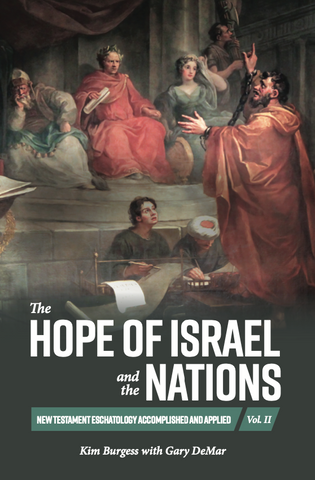Gary discusses the second volume of the book, The Hope of Israel and the Nations, and what Kim Burgess calls the “meta-hermeneutic” of the New Testament.
History cannot be “sliced and diced” without destroying it. History is an organic whole! One also has to understand what the German term, Sitz im Leben, the “situation in life,” is getting at, for it is vital. One has to take fully into account what the whole original situation in life was in which all of the Biblical documents were written in that day per the original audience relevance. So, in this exegetical work, I am trying to get behind the text or above it, as it were. I am constructing what might be called the NT’s “meta-hermeneutic.” … I am trying, through Scripture, to get back into Paul’s mind or John’s mind or Peter’s mind or Apollos’ mind in their day and time in OT Israel and reconstruct as fully as I can, from all the relevant Biblical data, what the redemptive-historical and covenantal worldview was that they themselves had in their day. What was the eschatological worldview from and out of which they wrote the documents that we have from them?
First and foremost, the Bible is a history book. What is more, it is a particular people’s history book when it was given or written—the “oracles of God” were given to Israel (Rom. 3:2)! Yes, for sure, the Bible is also a devotional book—think of the Psalms!— but it is not like some book full of isolated aphorisms like those of Confucius! Since the Bible is a history book, and since this history of redemption is indeed covenantally-structured, we must understand this history and its covenant structure first if we really want to understand properly what the Bible is saying and why, for its original audience and for us today.

The Hope of Israel and the Nations (Volume 2)
In this second and concluding volume of The Hope of Israel and the Nations, Kim Burgess continues expounding his lessons on New Testament Eschatology. With help from co-author Gary DeMar, Kim connects all the parts of the NT and fashions them into a whole. Kim emphasizes the one-and-many approach to interpretation. The parts and the whole must be studied together. They make up the warp and woof of proper biblical interpretation. The process takes time and study, but it brings the full story of the Bible into clear focus.
Buy NowVolume 2 of Kim Burgess and Gary DeMar’s The Hope of Israel and the Nations is now available! Gary discusses the book, the series, and what Kim calls the “meta-hermeneutic” of the New Testament (p. 13). Why did Paul write letters and Luke write “historical documents?” Each writing had a particular motivation behind it and we must take this into consideration when interpreting them.

